Abstract
The mean serum hyaluronate concentration in a group of patients with rheumatoid arthritis (n = 37) was 232 +/- 182 (SD) microgram/l and significantly greater (p less than 0.001) than that of age and sex matched healthy controls (mean level 42 +/- 25 micrograms/l) as well as that of patients with ankylosing spondylitis (mean level 58 +/- 33 micrograms/l). In rheumatoid arthritis positive correlations were found between serum hyaluronate and acute-phase plasma proteins, while neither rheumatoid factor titre nor the presence of circulating immune complexes were related to the hyaluronate levels. Increased serum hyaluronate could not be explained by impaired renal or liver function or by drug therapy. During treatment with corticosteroids but not with non-steroidal anti-inflammatory drugs the serum hyaluronate concentrations were significantly reduced. The data obtained suggested an increased production of hyaluronate in rheumatoid arthritis, and the increase seems to be related to the activity of the inflammatory process.
Full text
PDF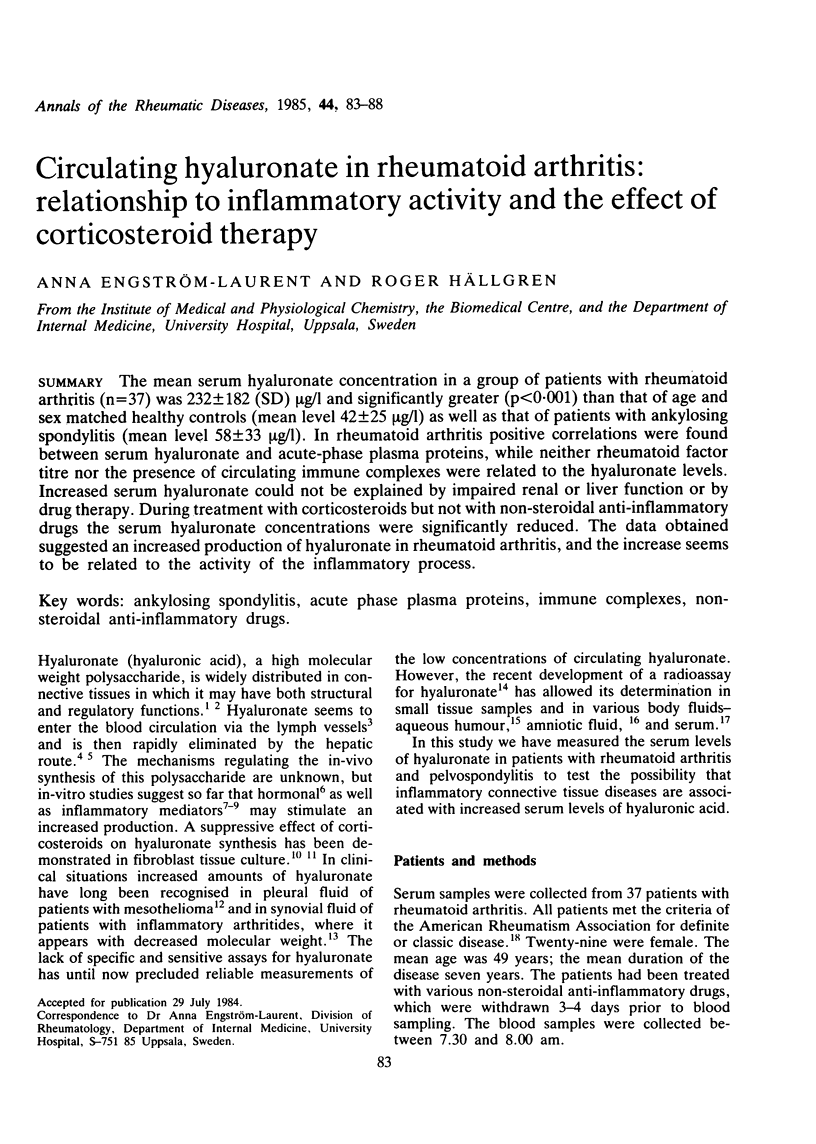
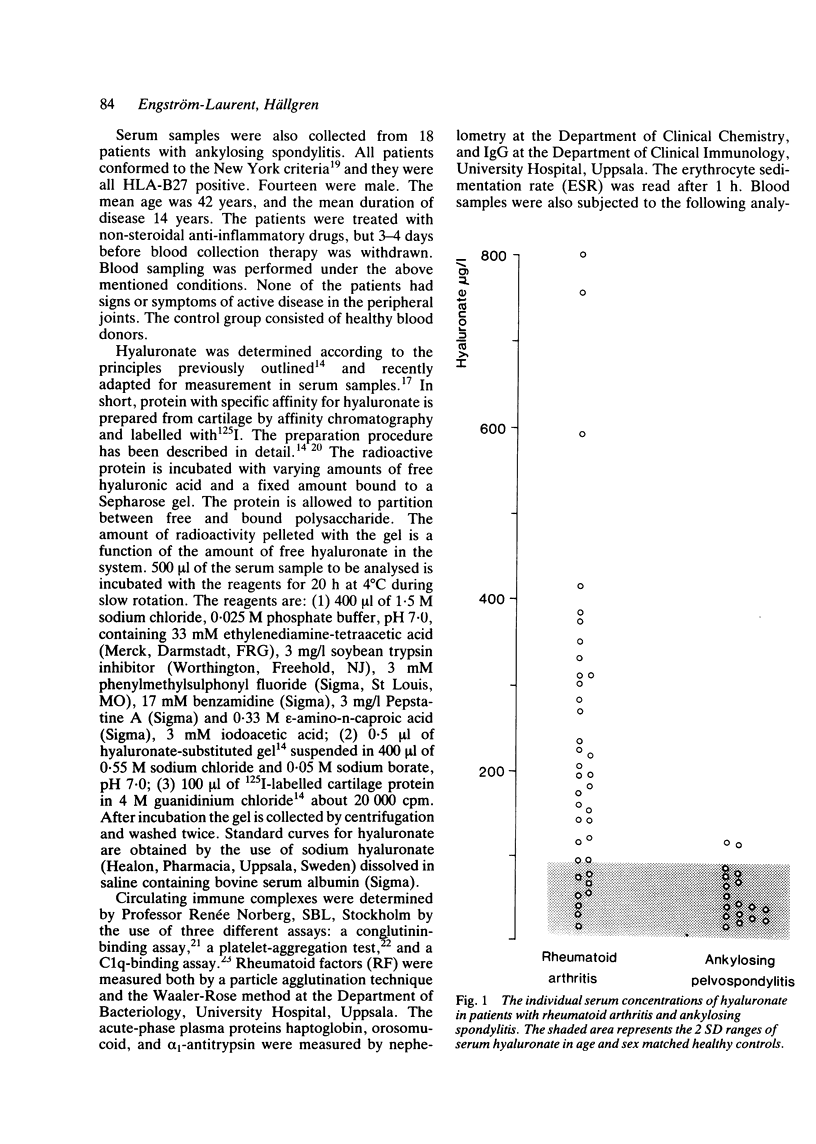
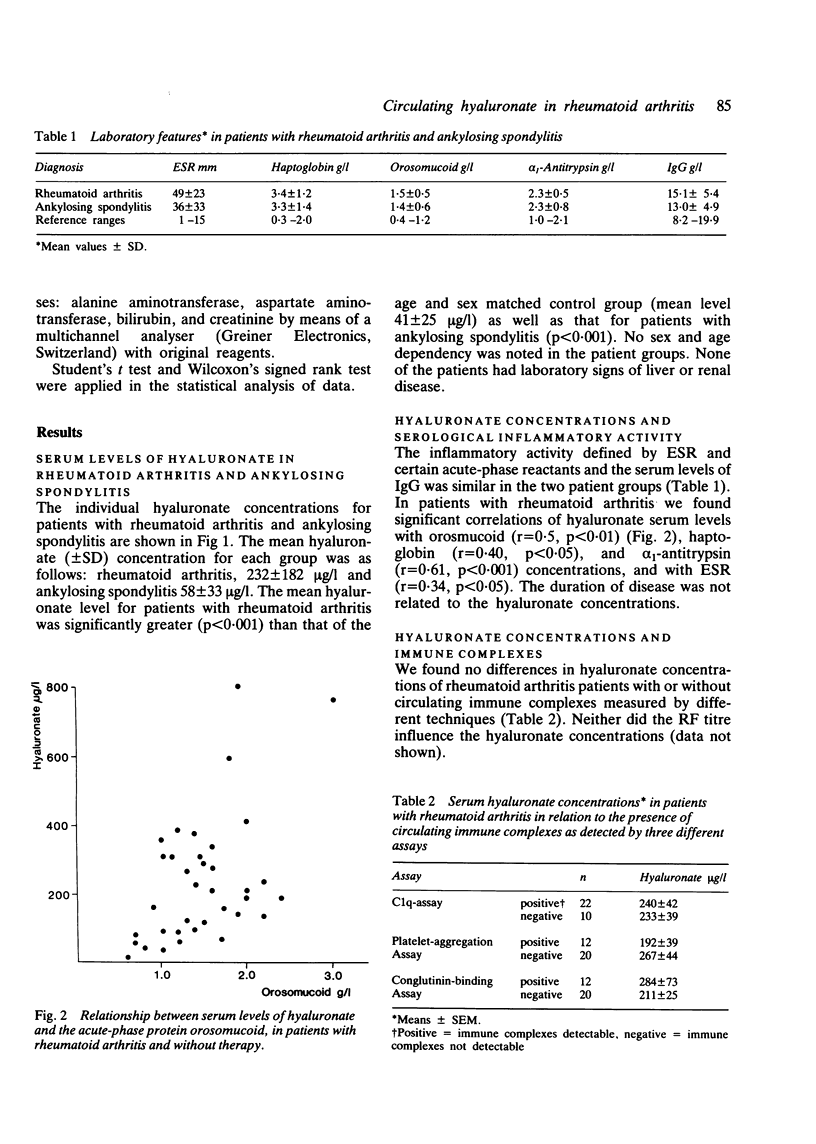
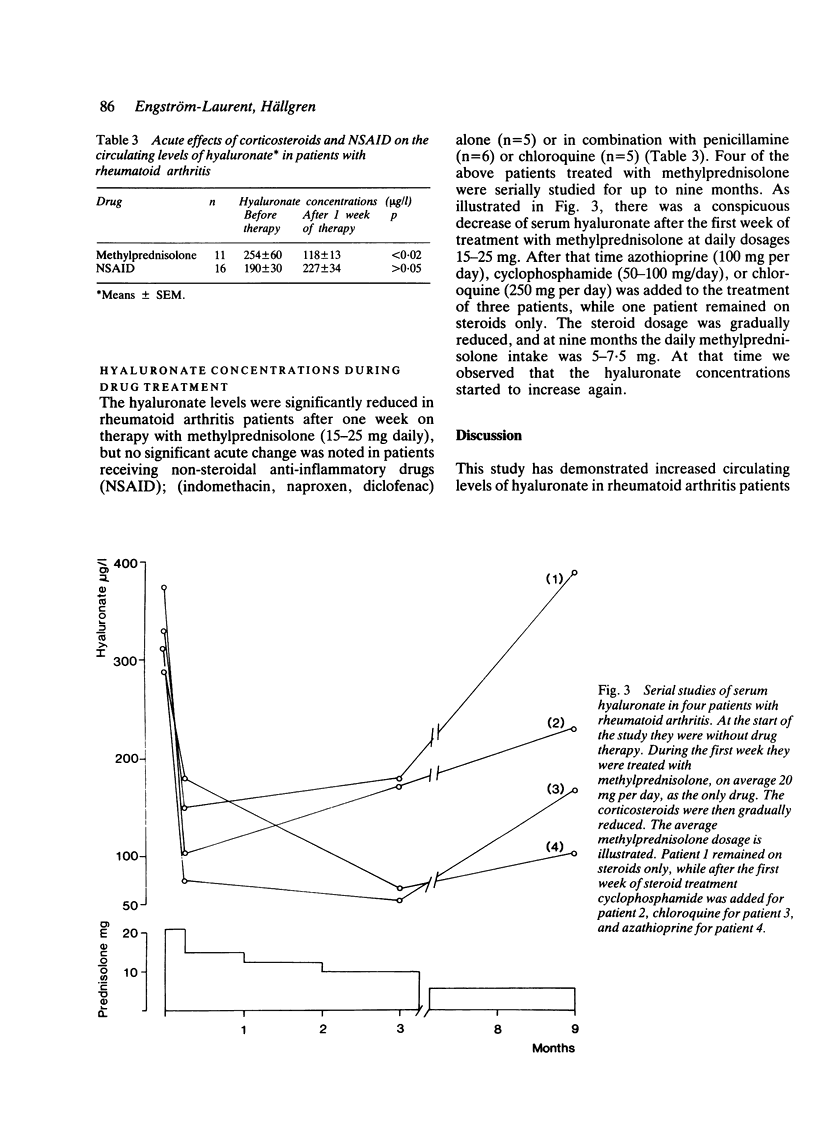
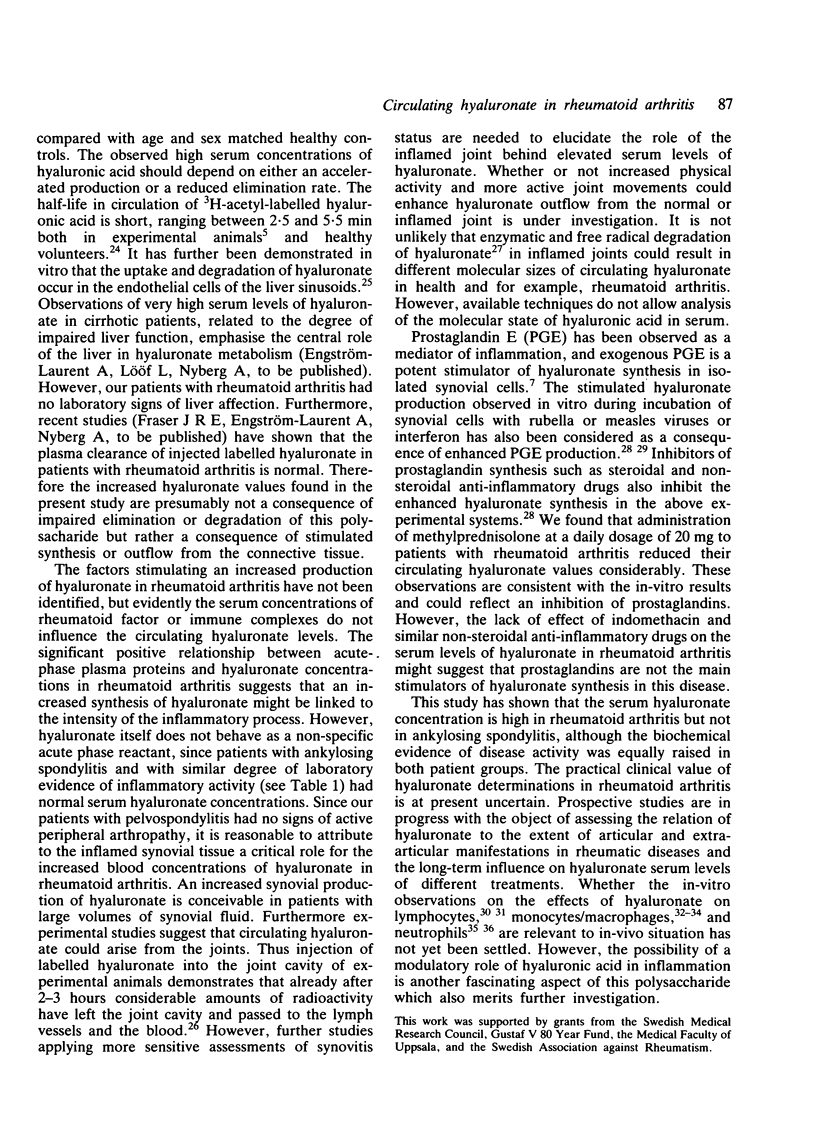
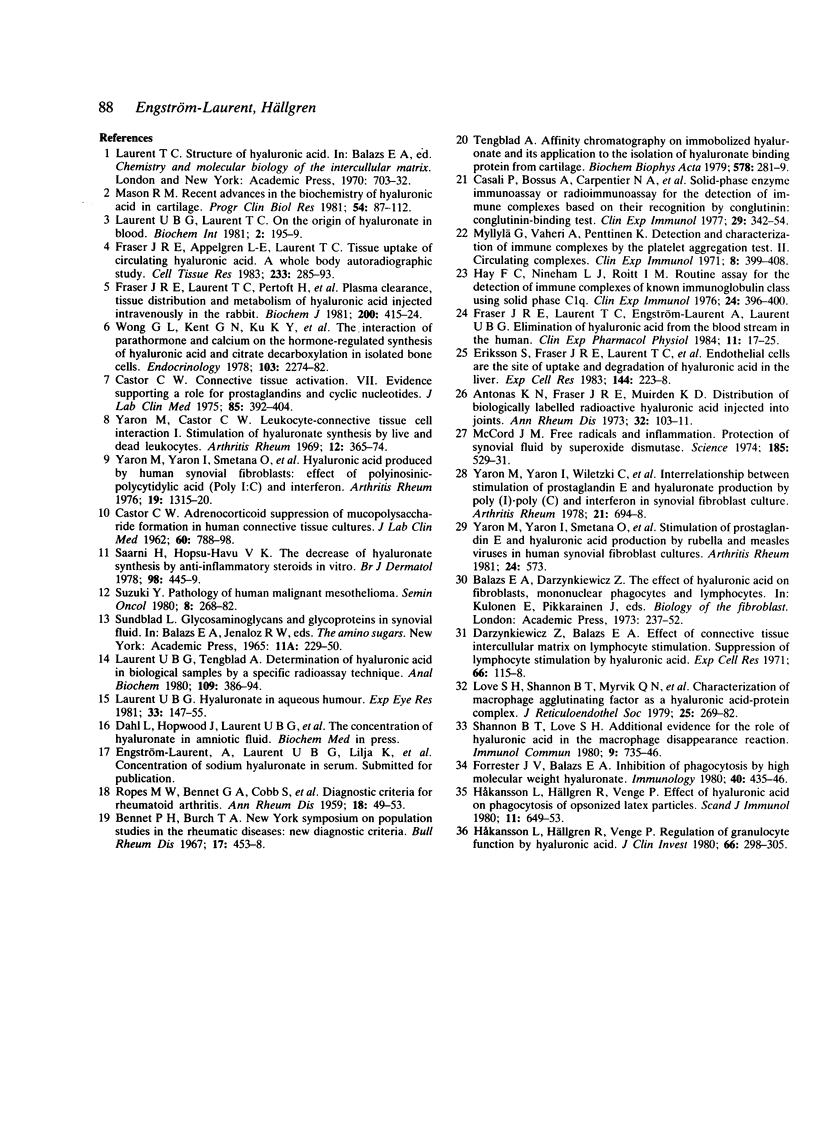
Selected References
These references are in PubMed. This may not be the complete list of references from this article.
- Antonas K. N., Fraser J. R., Muirden K. D. Distribution of biologically labelled radioactive hyaluronic acid injected into joints. Ann Rheum Dis. 1973 Mar;32(2):103–111. doi: 10.1136/ard.32.2.103. [DOI] [PMC free article] [PubMed] [Google Scholar]
- CASTOR C. W. Adrenocorticoid suppression of mucopoly-saccharide formation in human connective tissue cell cultures. J Lab Clin Med. 1962 Nov;60:788–798. [PubMed] [Google Scholar]
- Casali P., Bossus A., Carpentier N. A., Lambert P. H. Solid-phase enzyme immunoassay or radioimmunoassay for the detection of immune complexes based on their recognition by conglutinin: conglutinin-binding test. A comparative study with 125I-labelled Clq binding and Raji-cell RIA tests. Clin Exp Immunol. 1977 Aug;29(2):342–354. [PMC free article] [PubMed] [Google Scholar]
- Castor C. W. Connective tissue activation. VII. Evidence supporting a role for prostaglandins and cyclic nucleotides. J Lab Clin Med. 1975 Mar;85(3):392–404. [PubMed] [Google Scholar]
- DIAGNOSTIC criteria for rheumatoid arthritis: 1958 revision by a committee of the American Rheumatism Association. Ann Rheum Dis. 1959 Mar;18(1):49–53. [PMC free article] [PubMed] [Google Scholar]
- Eriksson S., Fraser J. R., Laurent T. C., Pertoft H., Smedsrød B. Endothelial cells are a site of uptake and degradation of hyaluronic acid in the liver. Exp Cell Res. 1983 Mar;144(1):223–228. doi: 10.1016/0014-4827(83)90458-5. [DOI] [PubMed] [Google Scholar]
- Forrester J. V., Balazs E. A. Inhibition of phagocytosis by high molecular weight hyaluronate. Immunology. 1980 Jul;40(3):435–446. [PMC free article] [PubMed] [Google Scholar]
- Fraser J. R., Appelgren L. E., Laurent T. C. Tissue uptake of circulating hyaluronic acid. A whole body autoradiographic study. Cell Tissue Res. 1983;233(2):285–293. doi: 10.1007/BF00238296. [DOI] [PubMed] [Google Scholar]
- Fraser J. R., Laurent T. C., Engström-Laurent A., Laurent U. G. Elimination of hyaluronic acid from the blood stream in the human. Clin Exp Pharmacol Physiol. 1984 Jan-Feb;11(1):17–25. doi: 10.1111/j.1440-1681.1984.tb00235.x. [DOI] [PubMed] [Google Scholar]
- Fraser J. R., Laurent T. C., Pertoft H., Baxter E. Plasma clearance, tissue distribution and metabolism of hyaluronic acid injected intravenously in the rabbit. Biochem J. 1981 Nov 15;200(2):415–424. doi: 10.1042/bj2000415. [DOI] [PMC free article] [PubMed] [Google Scholar]
- Hay F. C., Nineham L. J., Roitt I. M. Routine assay for the detection of immune complexes of known immunoglobulin class using solid phase C1q. Clin Exp Immunol. 1976 Jun;24(3):396–400. [PMC free article] [PubMed] [Google Scholar]
- Håkansson L., Hällgren R., Venge P. Effect of hyaluronic acid on phagocytosis of opsonized latex particles. Scand J Immunol. 1980;11(6):649–653. doi: 10.1111/j.1365-3083.1980.tb00034.x. [DOI] [PubMed] [Google Scholar]
- Håkansson L., Hällgren R., Venge P. Regulation of granulocyte function by hyaluronic acid. In vitro and in vivo effects on phagocytosis, locomotion, and metabolism. J Clin Invest. 1980 Aug;66(2):298–305. doi: 10.1172/JCI109857. [DOI] [PMC free article] [PubMed] [Google Scholar]
- Laurent U. B. Hyaluronate in aqueous humour. Exp Eye Res. 1981 Aug;33(2):147–155. doi: 10.1016/s0014-4835(81)80063-2. [DOI] [PubMed] [Google Scholar]
- Laurent U. B., Tengblad A. Determination of hyaluronate in biological samples by a specific radioassay technique. Anal Biochem. 1980 Dec;109(2):386–394. doi: 10.1016/0003-2697(80)90665-x. [DOI] [PubMed] [Google Scholar]
- Love S. H., Shannon B. T., Myrvik Q. N., Lynn W. S. Characterization of macrophage agglutinating factor as a hyaluronic acid-protein complex. J Reticuloendothel Soc. 1979 Mar;25(3):269–282. [PubMed] [Google Scholar]
- Mason R. M. Recent advances in the biochemistry of hyaluronic acid in cartilage. Prog Clin Biol Res. 1981;54:87–112. [PubMed] [Google Scholar]
- McCord J. M. Free radicals and inflammation: protection of synovial fluid by superoxide dismutase. Science. 1974 Aug 9;185(4150):529–531. doi: 10.1126/science.185.4150.529. [DOI] [PubMed] [Google Scholar]
- Myllylä G., Vaheri A., Penttinen K. Detection and characterization of immune complexes by the platelet aggregation test. II. Circulating complexes. Clin Exp Immunol. 1971 Mar;8(3):399–408. [PMC free article] [PubMed] [Google Scholar]
- Saarni H., Hopsu-Havu V. K. The decrease of hyaluronate synthesis by anti-inflammatory steroids in vitro. Br J Dermatol. 1978 Apr;98(4):445–449. doi: 10.1111/j.1365-2133.1978.tb06539.x. [DOI] [PubMed] [Google Scholar]
- Shannon B. T., Love S. H. Additional evidence for the role of hyaluronic acid in the macrophage disappearance reaction. Immunol Commun. 1980;9(8):735–746. doi: 10.3109/08820138009109683. [DOI] [PubMed] [Google Scholar]
- Suzuki Y. Pathology of human malignant mesothelioma. Semin Oncol. 1981 Sep;8(3):268–282. [PubMed] [Google Scholar]
- Tengblad A. Affinity chromatography on immobilized hyaluronate and its application to the isolation of hyaluronate binding properties from cartilage. Biochim Biophys Acta. 1979 Jun 19;578(2):281–289. doi: 10.1016/0005-2795(79)90158-2. [DOI] [PubMed] [Google Scholar]
- Wong G. L., Kent G. N., Ku K. Y., Cohn D. V. The interaction of parathormone and calcium on the hormone-regulated synthesis of hyaluronic acid and citrate decarboxylation in isolated bone cells. Endocrinology. 1978 Dec;103(6):2274–2282. doi: 10.1210/endo-103-6-2274. [DOI] [PubMed] [Google Scholar]
- Yaron M., Yaron I., Smetana O., Caspi D., Zor U. Stimulation of prostaglandin E and hyaluronic acid production by rubella and measles viruses in human synovial fibroblast cultures. Arthritis Rheum. 1981 Mar;24(3):573–573. doi: 10.1002/art.1780240330. [DOI] [PubMed] [Google Scholar]
- Yaron M., Yaron I., Smetana O., Eylan E., Herzberg M. Hyaluronic acid produced by human synovial fibroblasts. Effect of polyinosinic-polycytidylic acid (poly I:C) and interferon. Arthritis Rheum. 1976 Nov-Dec;19(6):1315–1320. doi: 10.1002/art.1780190612. [DOI] [PubMed] [Google Scholar]
- Yaron M., Yaron I., Wiletzki C., Zor U. Interrelationship between stimulation of prostaglandin E and hyaluronate production by poly (I) . poly (C) and interferon in synovial fibroblast culture. Arthritis Rheum. 1978 Jul-Aug;21(6):694–698. doi: 10.1002/art.1780210614. [DOI] [PubMed] [Google Scholar]


